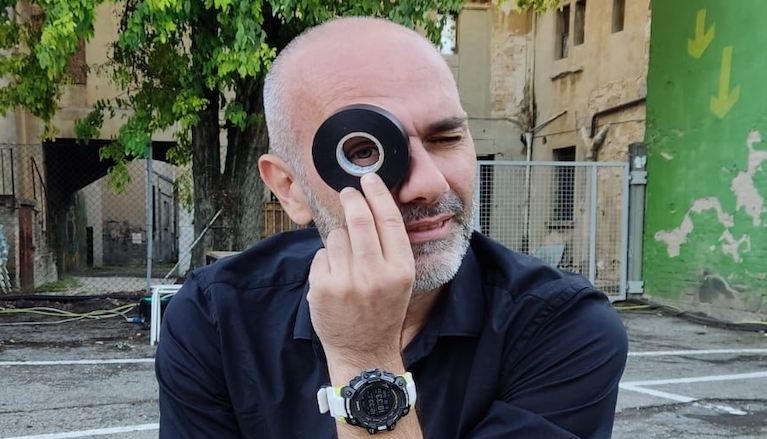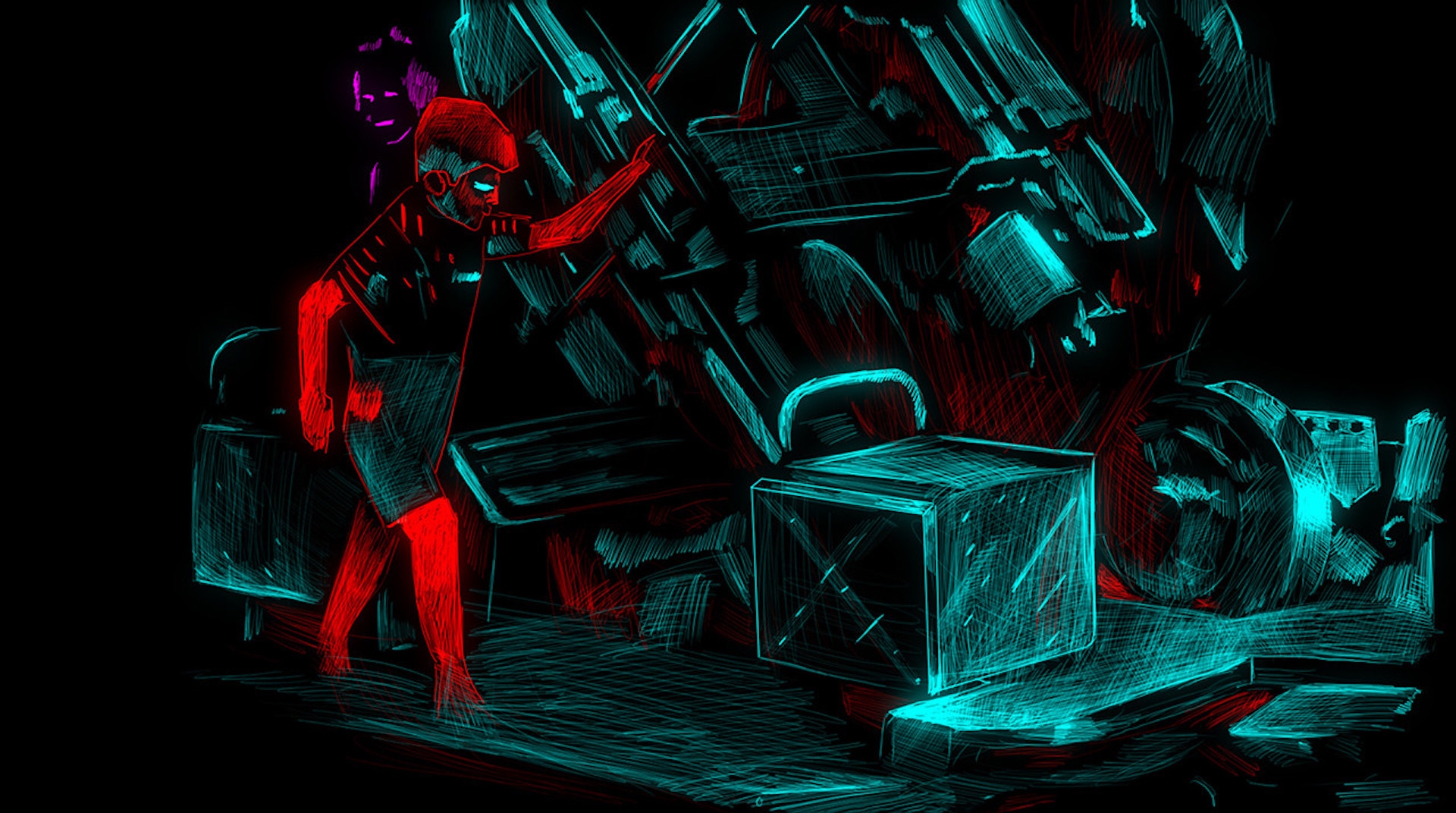Focus Igor Imhoff
Alla presenza del regista e del curatore Pierpaolo Loffreda
Pierpaolo Loffreda
Igor Imhoff, hailing from Apulia, lives in Venice and teaches at the Urbino Academy of Fine Arts. He is an established top-notch author who works not only as a visual artist but also as a software designer and video game developer, experimenting with new expressive forms based on a deeply-rooted cultural awareness. He makes mostly 3D digital pictorial works by way of innovative technological instruments taking inspiration from the most ancient suggestions in history, i.e., Palaeolithic cave paintings. Around 40,000 years ago, our predecessors (Homo Sapiens, just like us) began to practice artistic expression, in large caves that worked at once as temples of mystery cults and ‘exhibition venues.’ On the walls of those locations, lit by torchlights, they would outline drawings and evocative pictures. Some of them we can still understand now: big predators, wild beasts, anthropomorphic figures, sometimes fighting scenes; others have a strictly symbolic nature, such as handprints, spirals, crosses, and other signs difficult to interpret but still found in the art of Sub-Saharan Africa (from where we all come). The fascination all this still exerts is understandable – an unbroken vital flow – also keeping in mind that these ancestral expressive forms may have foreshadowed the notion and practice of moving images. Some of the pictures found in the caves actually are arranged in such a way as to give the illusion of motion, thanks to the lighting. Imhoff himself has commented on the relationship between primordial sign and notion of moving images in cave paintings: “Hands, human and animal figures, mysterious signs drawn on the domes of the caves, made thousands of years ago, refer to and evoke a grandiose imaginary universe of moments of real, everyday life or events of fantasy revealing the nature, anxieties, and search for sacredness. (...) Primitive paintings are permeated with motion. They are never static: they always represent an action in the making. Animals are running or showing off their strength. Sign reiteration is not a play of perspectives, but the demonstration of a possibly universal motion in which the way signs are arranged is reminiscent of film frames.”
In the cinema of Igor, these forms have influenced the imaginative dimension that the digital made possible. In the first place, they form the basis of deformation intended as a journey towards knowledge, according to Carlo Emilio Gadda’s formulation, who was the first to assert this view (see Meditazione milanese, 1928). In Imhoff’s films, the grotesque deals with visionary frameworks and dystopic conceptions (we live in the country of the Ustica massacre and the world were Sacco and Vanzetti were killed, reminds the artist) as well as ancestral myths. They indeed depart from those ‘primitive’ inventions: our ancestors’ art was actually grounded in concrete facts, like that of ancient and modern-day Africans. It was ‘useful’ to do something, to try and obtain some result. Another source of inspiration for the cinema of Imhoff, one that we cherish, is cyberpunk, beginning with RanXerox, the comic series conceived by Stefano Tamburini and made in collaboration Tanino Liberatore and Andrea Pazienza (it was initially published in Cannibale, 1978, and in Frigidaire from 1980). Les us point out that Ridley Scott’s (Philip K. Dick’s) Blade Runner is dated 1982, and David Cronenberg’s Scanners and Videodrome respectively 1981 and 1984 – great years for imagination! Add the Daunians: a pre-Roman Italic population that inhabited a region mostly coincident with the current province of Foggia from the eighth to the fifth century BC. Their refined sculpture expressed original symbolic depictions – later to be found also elsewhere, a testimony to the fact that we are one large people with shared archetypes – and evokes fantasy figures, especially in Imhoff’s film Anafora, with its ghostlike creatures recreated thanks to the digital approach. Another constant reference to be found in Imhoff’s works seems to be the cinema of the historical, 1920’s avant-gardes. All of these components, including archaic symbols, metamorphoses, fire and colour, and circular time (the spiral: one of human culture’s most ancient and most deep-rooted shapes) holds together precisely thanks to digital processing. In the artist’s words, “Owing to the finally moving image, to cinema, and related experimentations, it is now possible to reinterpret ancestral art with a new, possibly daring angle, speculating that underlying the pictures is a willingness to describe less events than motion and action. The sign has a deeper meaning.” It is this capacity of combining synthetically – thanks to the new technologies – primaeval references with the dimension of a potential future that seems to be the trade mark of Igor Imhoff’s films, along with one of the most interesting ways of living the Zeitgeist.

A 16-bit video game developer and later digital artist, Igor Imhoff works mainly with moving images and visual experimentation. His research passionately combines primitive, symbolic, and anthropological elements with digital art, energetically driven towards an avant-garde taste. In his work several dichotomies can be found, and the result is exponentially brilliant. The synthetic image of Small White Dot vs. the archaic figures of his series Percorsi; Anafora, reminiscent of cave paintings but conceived as an interactive installation, vs. the collaboration with the Polo Museale Veneto, where cave paintings are paired with the pre-cinema experiments of Muybridge and Duchamp; it’s different sides of the same eternal human need to represent the world and find a compromise to live with it. Imhoff’s research is focussed on experimentation in all its forms, from 2D to 3D, to immersive VR. His production alternates between animation video and design of interactive works, ranging from video mapping to theatrical performances. Numerous exhibitions and participations in festivals and shows in Italy and abroad, in which he has often garnered awards. He currently teaches Digital Applications for Art and Multimedia Languages at the Academy of Fine Arts in Urbino as well as Digital Animation Techniques at the Academy of Fine Arts in Venice. He also teaches Special Effects and VR at the Fine Arts in Filmmaking first-level Professional Master’s Programme at Ca’ Foscari University in Venice.
Pierpaolo Loffreda
What was your cultural education like?
Following technical training and one year in IT at university, I continued and completed my studies at the Academy of Fine Arts, majoring in painting. At the same time, I developed and conceived video games.
And how was your artistic journey?
I had the strangest career: I went to the Academy to acquire a solid basis for the graphics of my video game projects. Thus, I discovered painting – in the traditional sense – and then the love for cave paintings and their symbology. Only after completing my studies, out of mere whim I decided to mix these experiences and create animated paintings in which the painted sign can take life and emit sounds. From that moment onwards, I have never ceased experimenting with the moving image in its many different forms, from music videos to immersive installations
.
Departing from the notion announced by Borges that “every writer creates his own precursors,” which authors and movements have had more influence on you, and how do you think you gave them a new life?
We could actually depart from Borges, who has had a strong impact on my research (I am thinking of The Garden of Forking Paths, among others). In general, I have always taken inspiration from several sources; especially certain writings by René Guenon or Elémire Zolla and others have helped give a direction to my work. I am attracted to primordial art, to its extreme synthesis, and the ambiguousness of the interpretations that we, in our present, manage to make of it. Regarding the visual arts, I am mostly interested in the avant-gardes, and in general in all pictorial Informalism. I have focused on so many artists throughout my education, but on the fly (and without any order), I’d say: Tapiès, Kentridge, Malevich, Fischinger, McLaren, Cuba, Gondry, and an endless list of works. Anyhow, I hoover up all sorts of things. I have often found ideas in music videos, animated films, and of course in video games. In my work, I always try to adapt diverse experiences and imaginaries to my worldview. Surely, I am more attracted to words and signs, that I arrange on a timeline in turns. The image always arrives at a later stage.
How do you conceive the image/sound relationship?
It’s not easy to give an answer. In the past few years, my work has developed deeper ties with music videos or live shows; therefore, I have a varied experience, and very often my images are set to be animated (played?) live. In general, and especially with animation, sound is the first element that I consider; there cannot be a sign or a motion without it having a voice. In several cases, I composed the sound too, as I consider it part and parcel of drawing signs. I define this kind of activity a sort of augmented painting, where my concern is not only of giving shape, but also of combining motion and voice.
Can you explain why you define yourself as a ‘software artist’?
I am a software artist to the extent that knowing application software and its characteristics is an integral part of my work. Technique and operative strategies lie on habitats made of programmes and algorithms. You get used to reasoning in terms that are not necessarily ‘analogue’ ones.
How to you manage your work as an artist along with that as a teacher at fine arts academies? How do students cope with new technologies in your opinion?
I’ll try to be brief. I can approach my educational activity in two ways: on one hand, you can teach what you do in your work; in this way, classes are varied and oriented not only towards explaining techniques, but also including how to resolve problems and human relationships. You convey a thorough and more involving experience. On the other hand, the point of view of the students and their approach is a source of ideas and inspiration. I have often put to practice the suggestions that came up during classes. Therefore, in my opinion teaching and training are deeply stimulating both ways. Whenever I can, I try to work with my pupils. As regards the students/new technologies relationship, it’s one more issue where it is difficult to express an opinion. Despite they are ‘digital natives’, many of them are insecure and scarcely inclined to trying things out, thus missing a large part of the potential that is now available. Technological advance is so fast that we are all unprepared for a new application; what makes the difference is, perhaps, some experi ence/cunning and, surely, the desire of experimenting, also keeping a critical eye on these instruments. When pupils overcome this insecurity, the teacher/learner relationship is subverted and working becomes stimulating and deeply effective.
ALL SCREENINGS ARE FREE




